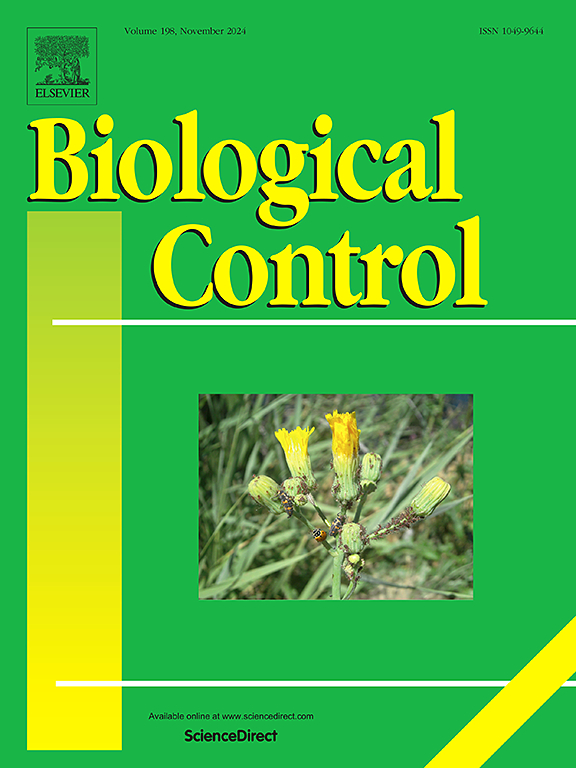Species distribution models reveal restricted areas for biological control of Bactrocera carambolae by its parasitoid Fopius arisanus in Brazil
IF 3.4
2区 农林科学
Q2 BIOTECHNOLOGY & APPLIED MICROBIOLOGY
引用次数: 0
Abstract
Fopius arisanus (Sonan) is an exotic parasitoid used to control Bactrocera spp. In Brazil, it is suggested as a control agent for Bactrocera carambolae Drew & Hancock. The pest is currently restricted to the northern territory of Brazil; however, temperature changes may lead to an increase in its distribution. Species distribution models (SDMs) can predict a species’ potential geographic range in a particular climate change scenario. We aimed to predict the susceptible areas for expanding and establishing B. carambolae and its parasitoid, F. arisanus in Brazil, particularly, in the Amazon region. Climate layers were extracted from bioclimatic variables, and Random Forest was used to predict the SMDs for both Brazilian species under two climatic scenarios (intermediary and extreme). Our predictions showed a larger suitability area for B. carambolae establishment than for its parasitoids. Although B. carambolae is widespread, especially in the North and Midwest, F. arisanus has a limited area from west of Ceará State to North and East of Amapá State. Fopius arisanus had a low chance of increasing its geographical area under both climatic scenarios. The parasitoids and their hosts were similarly influenced by bioclimatic variables [precipitation seasonality (BIO15) and annual precipitation (BIO12)]. Our results revealed a limited compatibility area for both B. carambolae and F. arisanus in the Brazilian territory, with potential expansion of the pest compared with its parasitoid. In this context, the country’s northern regions face a “red alert flag” for implementing strategies to prevent the spread of pests by releasing parasitoids.
物种分布模型揭示了巴西焦小蝇寄生蜂对焦小蝇生物防治的限制区域
沙蝇(Fopius arisanus, Sonan)是一种用于防治小实蝇的外来寄生蜂,在巴西被建议作为防治焦小实蝇的药剂。汉考克。这种害虫目前仅限于巴西北部地区;然而,温度变化可能导致其分布增加。物种分布模型(SDMs)可以预测特定气候变化情景下物种的潜在地理范围。目的是预测巴西,特别是亚马逊地区焦糖白僵菌及其寄生蜂阿里沙蝇的孳生易感区。从生物气候变量中提取气候层,利用随机森林预测了两种气候情景(中间和极端)下巴西两种树种的smd。我们的预测表明,与拟寄生物相比,焦糖白僵菌的适宜面积更大。尽管carambolae分布广泛,特别是在北部和中西部地区,但从西埃尔州到北和东埃尔州的范围有限。在这两种气候情景下,福皮乌斯·阿里萨努斯增加其地理面积的机会都很低。生物气候变量[降水季节性(BIO15)和年降水量(BIO12)]对拟寄生物及其寄主的影响相似。结果表明,在巴西境内,carambolae和arisanus的配种面积有限,与拟寄生虫相比,该害虫具有扩大的潜力。在这种情况下,该国北部地区在实施通过释放拟寄生虫来防止害虫传播的战略方面面临“红色警报”。
本文章由计算机程序翻译,如有差异,请以英文原文为准。
求助全文
约1分钟内获得全文
求助全文
来源期刊

Biological Control
生物-昆虫学
CiteScore
7.40
自引率
7.10%
发文量
220
审稿时长
63 days
期刊介绍:
Biological control is an environmentally sound and effective means of reducing or mitigating pests and pest effects through the use of natural enemies. The aim of Biological Control is to promote this science and technology through publication of original research articles and reviews of research and theory. The journal devotes a section to reports on biotechnologies dealing with the elucidation and use of genes or gene products for the enhancement of biological control agents.
The journal encompasses biological control of viral, microbial, nematode, insect, mite, weed, and vertebrate pests in agriculture, aquatic, forest, natural resource, stored product, and urban environments. Biological control of arthropod pests of human and domestic animals is also included. Ecological, molecular, and biotechnological approaches to the understanding of biological control are welcome.
 求助内容:
求助内容: 应助结果提醒方式:
应助结果提醒方式:


